SILVANA MOSSANO
Reportage udienza 29 marzo 2023
«Non ci fu né dolo né colpa nella condotta dell’imputato. Chiedo che il signor Schmidheiny sia assolto perché il fatto non sussiste per mancanza della prova sul nesso di causalità. In subordine, che sia assolto perché il fatto non costituisce reato». Sono le parole conclusive dell’arringa dell’avvocato Guido Carlo Alleva, codifensore dell’imprenditore svizzero accusato, nel processo Eternit Bis in Corte d’Assise a Novara, dell’omicidio volontario, con dolo eventuale, di 392 casalesi morti a causa dell’amianto. Il collega Astolfo Di Amato aveva svolto la prima parte di arringa nell’udienza del 10 marzo scorso.
I pubblici ministeri Gianfranco Colace e Mariagiovanna Compare avevano concluso la requisitoria chiedendo la condanna all’ergastolo.
Il presidente della Corte, Gianfranco Pezone, ha fissato la prossima udienza al 7 giugno: in quella data, dopo le repliche orali (consegneranno, preventivamente, le relazioni scritte entro metà maggio), i giudici si ritireranno in camera di consiglio per uscirne con la sentenza. Sarà, quella di giugno, la quarantaduesima udienza del filone casalese dell’Eternit Bis: due anni esatti di processo, iniziato il 9 giugno 2021.
LA DIFESA DELL’AVVOCATO ALLEVA
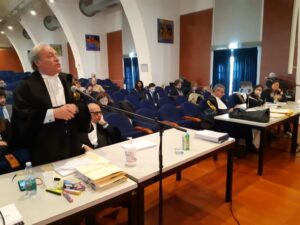
L’esordio del difensore, mercoledì 29 marzo, è stato accorato e, forse comprensibilmente, anche retorico, partendo dalla propria esperienza personale di fronte a «una situazione terribile, tragica. Ho giocato anch’io in Monferrato da ragazzino, su un campetto da pallone con il polverino, e un po’ di timore ce l’ho… E ho giocato con amici purtroppo morti di mesotelioma, cui va il mio commosso pensiero. Ma, qui, in quest’aula, devo esercitare il mio ruolo, nell’ambito del processo penale che ci contraddistingue per civiltà democratica e ci allontana dalla vendetta».
LA PREMESSA
«Ci confronteremo con il tempo – ha premesso l’avvocato Alleva -. Sarà un viaggio di andata e ritorno nel tempo: da un lato dobbiamo tornare agli anni ’70-’80 per vedere le cose in quella prospettiva, per capire il contesto di allora, in cui le persone sono vissute e si sono ammalate di mesotelioma, e, dall’altro lato, è doveroso essere consapevoli della sapienza scientifica dell’oggi».
Insomma, un po’ è utile tener conto di ieri, e un po’ è utile tener conto di oggi.
QUATTRO CAPITOLI
L’avvocato Alleva ha trattato quattro capitoli: 1) Usi Impropri. Il polverino; 2) La diagnosi; 3) Il nesso di causalità; 4) L’elemento soggettivo. Il dolo.
1 USI IMPROPRI. POLVERINO
Ampia trattazione è stata dedicata a questo argomento, anche perché il capo di imputazione fa specifico riferimento agli scarti di lavorazione e al polverino: l’accusa a Schmidheiny è di «non averne impedito la fornitura a privati ed enti pubblici» che li impiegarono per battuti di strade, cortili, aie, campi di calcio e coibentazione di sottotetti, provocando in tal modo una «esposizione incontrollata e continuativa».
L’avvocato Alleva rimarca la pericolosità di questi usi impropri, ma afferma che riguardano i settant’anni di gestione precedente quella degli svizzeri, subentrati ai belgi nei primi anni ‘70.
Ribadisce il difensore che l’impiego di questi scarti ha causato un inquinamento enorme: «Il polverino è ubiquo in Monferrato. A Casale e in tutti i paesi della collina: era in tutti i cortili, in tutti i pollai, in tutti gli oratori… io stesso ho giocato sul campetto di Vignale che era coibentato di polverino…».
Un momento: va bene la veemenza oratoria, però bisogna rimanere nei binari della concretezza, anche quando un argomento mira a dimostrare la tesi difensiva che i cosiddetti «usi impropri» erano pressoché equivalenti all’inquinamento prodotto dalla fabbrica e dai luoghi correlati. Scarti e polverino furono usati e diffusi, eccome, in città e nei paesi più vicini, intorno. In tanti e troppi siti di vita ci sono stati questi impieghi, ma non in tutti: non tutti i cortili, non tutti gli oratori, non tutte le piazze, non tutti i paesi, avvocato. Ad esempio, per correttezza, e anche per tranquillizzare il difensore Alleva e altri ex ragazzini dell’epoca, una verifica puntuale esclude che in qualsiasi campetto di Vignale su cui egli abbia giocato ci fosse il polverino. Giusto perché l’enfasi non si ingigantisca e scivoli nella suggestione, senza fondatezza reale.
Comunque, quel che interessa al difensore sottolineare, e lo ribadisce con forza, è che «gli svizzeri vietarono di far uscire scarti di produzione dallo stabilimento: sacchi, feltri, polverino, pezzi rotti. Vennero date istruzioni chiare in questo senso». Quindi, tutto quello che fu utilizzato, da dove veniva? «La distribuzione di polverino e scarti – afferma senza ombra di dubbio l’avvocato – era una prassi pregressa», cioè risalente al periodo belga, e non al decennio svizzero.
2 LA DIAGNOSI
Torniamo al capo di imputazione in cui è scritto che l’imputato, in qualità di effettivo gestore della Eternit spa (di cui faceva parte lo stabilimento di Casale), ha cagionato la morte di 392 persone per mesotelioma dovuto all’amianto. In altre parole, secondo l’accusa, Stephan Schmidheiny, con le sue azioni (o omissioni) avrebbe provocato i mesoteliomi e le morti.
Il mesotelioma, dunque, in questo processo è quello che in gergo viene definito «evento causale». Quindi, un elemento importante e fondante. Pertanto, Alleva è chiaramente categorico: «Sulle 392 diagnosi non ci deve essere che certezza», ossia si deve appurare senza margine di dubbio «se queste persone hanno davvero sviluppato il mesotelioma», altrimenti di quelle morti non può essere chiamato a rispondere l’imputato.
Per i consulenti della procura, che hanno revisionato caso per caso, si tratta di 392 diagnosi certe (62 ex lavoratori Eternit e 330 cittadini).
Per il consulente della difesa, l’anatomopatologo Massimo Roncalli, no; dei 354 casi da lui rivisti sul totale di 392 (per 38 non ha avuto a disposizione il materiale biologico e non ha eseguito analisi aggiuntive) è arrivato a queste conclusioni: 140 casi con diagnosi certa, 116 con diagnosi probabile, 98 con diagnosi possibile.
L’avvocato Alleva spiega: «Dobbiamo usare le cognizioni di cui disponiamo oggi (cioè i marcatori attuali per i test immunoistochimici, ndr) per dire che la diagnosi è certa. Dove è probabile o addirittura solo possibile potrebbe essere stato un cancro diverso: un altro tipo di carcinoma o metastasi di un altro tumore».
Esclude che, per confermare la certezza di una diagnosi, ci si basi sul tempo di sopravvivenza (che potrebbe essere comune ad altri tipi di patologie), o sui campioni citologici, o si ricorra a marcatori negativi, o alla valutazione del contesto ambientale; «ci vuole l’immunoistochimica» ovvero «un’indagine basata su alcuni selezionati e affidabili marcatori che, nel loro insieme, con la morfologia e la clinica portano a una diagnosi di certezza». E ancora: «In assenza di immunoistochimica, si può diagnosticare solo come “neoplasia mesoteliale”».
Secondo Alleva, invece, «l’approccio dei consulenti della procura per quanto riguarda le diagnosi è stato approssimativo».
E, quindi, «se c’è un margine di dubbio ovvero se non si ricostruisce in termini di totale certezza la diagnosi di mesotelioma non si può addivenire a una declaratoria di responsabilità». Il difensore vuole dire che, se la diagnosi non è certa secondo i criteri dell’immunoistochimica più attuale, adottati dal proprio consulente Roncalli, la Corte tragga le conseguenze per la propria decisione.
3 NESSO DI CAUSALITA’
In che cosa consiste il nesso di causalità? L’azione A causa l’effetto B, sulla base di leggi scientifiche condivise, e oltre ogni ragionevole dubbio. Come ha detto il difensore «il nesso causale è il “cuore” del processo penale»: bisogna essere certi che la condotta dell’imputato abbia causato l’evento (in questo processo, l’evento è l’insorgenza dei mesoteliomi).
Ora, si interroga l’avvocato Alleva, possiamo provare oltre ogni ragionevole dubbio che sia stato proprio il comportamento di Stephan Schmidheiny a causare la malattia di ognuna delle 392 persone elencate nel capo d’accusa?
Su alcuni aspetti, anche nel contraddittorio dei consulenti tecnici, si è registrata condivisione di vedute; ad esempio, che il mesotelioma è una patologia correlata all’amianto, che non c’è una dose-soglia al di sotto della quale si è sicuri di non ammalarsi, che le dosi più remote a cui si è stati esposti sono le più rilevanti per lo sviluppo del mesotelioma, che la latenza convenzionale è lunga e variabile e che c’è un momento in cui il tumore è irrimediabilmente formato nell’organismo anche se non si vede e non è ancora diagnosticabile: le esposizioni successive a questo momento sono irrilevanti, cioè non contano più ai fini della malattia.
La fase in cui il tumore si «forma», pur essendo ancora invisibile, si chiama «induzione». Per la difesa «non è possibile stabilire quando avviene il processo neoplastico», cioè «non si può collocare nel tempo quando il mesotelioma insorge».
Il difensore critica le argomentazioni dei consulenti della procura: per individuare i tempi, «utilizzano lo strumento epidemiologico, che consente di fare una valutazione statistica e probabilistica», ma, a suo parere, «trasfondere la valenza epidemiologica a livello del caso singolo è impossibile».
Per Alleva (e per i suoi consulenti) non si può stabilire se un determinato mesotelioma si è sviluppato nell’organismo di quella specifica persona per effetto di esposizione avvenuta proprio nel «periodo di garanzia» di cui è chiamato a rispondere l’imputato (cioè tra il 1976 e il 1986).
Respinge pure il concetto di «esposizione cumulativa», sul quale si fondano diversi studi di cui hanno dato conto i consulenti della procura Corrado Magnani e Dario Mirabelli, e cioè che tutte le esposizioni successive a quelle iniziali vanno comunque prese in considerazione perché tutte hanno dato un contributo all’insorgere della malattia.
La difesa rigetta questa tesi perché frutto della scienza epidemiologica, e ripete quanto già detto: «L’osservazione di ciò che accade in un gruppo di individui non può applicarsi al singolo individuo». Cosa che, avevano già replicato i consulenti della procura, è invece prassi ampiamente consolidata, ad esempio, quando si testa un farmaco.
4 ELEMENTO SOGGETTIVO. IL DOLO
Elemento soggettivo: è un capitolo delicato e complesso. E difficile da capire e da spiegare. Proveremo a semplificarlo per renderne il più accessibile possibile la comprensione soprattutto ai non addetti ai lavori.
Perché ci sia un reato non basta che una persona tenga un comportamento illecito (magari con la conseguenza di un evento), ma occorre anche che quella persona abbia espresso la volontà di tenere quella condotta illecita.
Lo stabilisce l’articolo 42 del Codice penale: «Nessuno può essere punito per una azione o omissione prevista dalla legge come reato se non l’ha commessa con coscienza e volontà».
In questo consiste l’elemento soggettivo, che può esprimersi in forme diverse: dolo (secondo l’intenzione), colpa (senza l’intenzione), preterintenzione (oltre l’intenzione).
Grosso modo, c’è il dolo quando una persona compie un’azione consapevole di compiere un reato (spara sapendo e volendo uccidere), c’è la colpa quando il reato è la conseguenza di una disattenzione, di una negligenza, di una imperizia (l’automobilista imprudente investe il pedone che muore, ma non aveva intenzione di ucciderlo).
Il dolo può essere intenzionale o eventuale. Nel processo Eternit Bis all’imputato Stephan Schmidheiny viene contestato il reato di omicidio volontario, con dolo eventuale.
DOLO EVENTUALE E COLPA COSCIENTE
I caratteri distintivi del dolo eventuale sono molto vicini a quelli della colpa cosciente, tanto che la distinzione è spesso complessa e sottile.
Si tratta di due tipologie di responsabilità che presentano molte affinità.
Uno snodo fondamentale, per distinguerle, è rappresentato dalla «accettazione del rischio»: accettare, cioè, che, a seguito di una propria condotta, si verifichi un evento che la legge considera reato.
Nel caso del dolo eventuale, ci si rappresenta la possibilità che l’evento si verifichi, si accetta il rischio e non si recede dalla volontà di agire.
Nel caso della colpa cosciente, ugualmente ci si rappresenta le conseguenze della propria condotta, ma si reputa improbabile che quelle conseguenze si verifichino o si ritiene di poterle comunque controllare o dominare.
Partiamo da un esempio generico: il datore di lavoro che omette di attuare nella propria azienda le cautele necessarie per evitare danni ai dipendenti. E’ dolo eventuale o colpa cosciente? Proviamo a esaminare il caso utilizzando – come hanno fatto pm e difesa – alcuni indici che non sono presenti nel Codice, ma contenuti nella sentenza ThyssenKrupp, che fa giurisprudenza.
A Finalità: Ha agito accettando il rischio di nuocere perché metteva il profitto al di sopra della sicurezza dei lavoratori, oppure la sua condotta è stata frutto di negligenza e sciatteria?
B Durata: ha omesso quelle cautele per anni oppure per un tempo limitato, magari qualche settimana, o qualche mese?
C Comportamento successivo: si è attivato per attenuare il danno o eliminarlo, oppure no?
D Grado culturale e personalità: qual era il livello di preparazione e competenza nel settore in cui operava?
LA CONDOTTA DELL’IMPUTATO
Proviamo ora a osservare la condotta dell’imprenditore svizzero alla luce di questa griglia, riportando via via le tesi difensive, argomentate punto per punto dall’avvocato Alleva.
Secondo l’accusa mossa dalla procura, il comportamento di Schmidheiny sarebbe stato questo: l’industriale si sarebbe rappresentato che, continuando la produzione di amianto, avrebbero potuto morire centinaia di persone, ma comunque lo ha fatto, ha continuato a produrre, perché questo faceva parte della sua decisione, della sua precisa scelta.
A Finalità – I pubblici ministeri Colace e Compare sostengono che l’imputato non ha adeguatamente investito in sicurezza e prevenzione, consentendo una diffusione indiscriminata di amianto e una esposizione grave per le persone, perché ha prevalso il suo interesse per il profitto e la tutela della propria consistente fetta di mercato.
Il difensore replica: «Fine di lucro? No, anzi ci ha perso. Non ho visto vantaggi economici nei bilanci di 10 anni. Schmidheiny ha sostenuto spese ingenti per la sicurezza. Carlo Castelli (prima commissario giudiziale nel concordato preventivo Eternit e poi curatore nel fallimento della Holding Eternit spa, ndr) ha scritto che la Eternit era svantaggiata nella competizione con le aziende concorrenti perché aveva sostenuto spese per la sicurezza che altri non sostenevano». Alleva insiste: «Nessuna altra azienda del settore ha dimostrato uguale sensibilità e attenzione nel cercare di limitare il rischio; non mi pare ci siano state altre aziende… la concorrente Fibronit, ad esempio… che si siano dotate di organismi di controllo per la rilevazione delle fibre come il Sil e il Copae nell’Eternit».
Va avanti: «Quale avrebbe dovuto essere le “condotta alternativa lecita” di Schmidheiny? Per il pubblico ministero la condotta alternativa lecita avrebbe dovuto essere la sospensione dell’attività. Smettere e chiudere le fabbriche. Solo per Eternit? Per le altre concorrenti no? Né per le Ferrovie dello Stato, né per i cantieri navali, né per le aziende che fabbricavano le tute ignifughe all’amianto degli automobilisti o dei vigili del fuoco?».
La procura, da parte propria, ritiene che gli investimenti furono insufficienti e non finalizzati prioritariamente alla sicurezza, ma si trattò per lo più di finanziamenti per coprire perdite croniche.
Il difensore scuote la testa: «Dobbiamo calarci nel contesto storico di quell’epoca, di quel che si sapeva, delle certezze scientifiche, dobbiamo essere là in quella attività industriale, in quel contesto economico, in quello scenario in cui i fatti sono avvenuti e i comportamenti si sono consumati». Illustra diversi documenti, per esempio quelli prodotti dalla Comunità Europea, tra il 1973 e il 1985, sul tema amianto e salute. Ne richiama in particolare uno del 1979, in cui il Comitato Europeo Economico Sociale (il Cese, un organismo consultivo della allora Cee, oggi Ue, in rappresentanza delle organizzazioni dei lavoratori e dei datori di lavoro) esprime, sì, preoccupazione sull’incidenza del mesotelioma in seguito all’esposizione all’amianto, «ma afferma anche – riporta Alleva – che “non è realistico pensare a una indiscriminata messa al bando dell’amianto”», pur affermando al contempo, però, che «non è ammissibile l’esposizione dei lavoratori».
Il difensore cita altresì una lettera del 1983 in cui Benedetto Terracini, medico ed epidemiologo di fama internazionale, e Enrico Anglesio, oncologo e fondatore del Registro Tumori del Piemonte, manifestavano serie preoccupazioni perché intravedevano i segnali di una possibile futura epidemia di tumori dovuti all’esposizione all’amianto. «Sì – ammette l’avvocato -, c’era una preoccupazione, ma non certezze scientifiche, che arrivano più tardi» e richiama, in particolare, un’affermazione dell’epidemiologo Corrado Magnani: «Solo all’inizio degli anni Duemila le evidenze epidemiologiche consentono di affermare con certezza che l’insorgenza del mesotelioma è legata anche alle esposizioni non professionali e che pertanto è necessario addivenire al divieto totale delle lavorazioni e di prodotti contenenti amianto».
Qui Magnani, invero, dà conto degli studi condotti sulla popolazione, ma i dati riguardanti i lavoratori (e poi i famigliari) sono risalenti agli anni Ottanta. Tanto per fare un esempio, la tesi di specialità di un medico casalese, che studiava l’elevata incidenza di mesoteliomi nel Casalese, fu illustrata dal primario di Medicina dell’ospedale Santo Spirito in un convegno pubblico del 1984.
Alleva esorta: «Torniamo a quell’epoca, agli anni Settanta», ed è granitico: «Si pensava, allora, di poter governare l’amianto».
In verità, Schmidheiny, nel congresso di Neuss del 1976, dopo aver illustrato ai suoi massimi dirigenti gli effetti cancerogeni dell’amianto, si espresse più dettagliatamente in questi termini, come emerge dai verbali: «Dobbiamo renderci conto di una cosa: noi possiamo, anzi dobbiamo convivere con questo problema». E, pochi mesi dopo, uscì il manuale Auls 76 contenente le linee di condotta impartite ai dirigenti: «Non fatevi prendere dal panico», con tanto di indicazioni su come rispondere a chi faceva domande. Come bisognava rispondere? Minimizzando la pericolosità dell’amianto e dando rassicurazioni.
B Durata – La condotta dell’imputato si sviluppa, come più volte ripetuto, per la durata dei dieci anni tra il 1976 e il 1986. L’avvocato Alleva ha rimarcato gli «ingenti investimenti effettuati in quel decennio per mettere in sicurezza il settore industriale di cui era a capo e che svolgeva un’attività lecita e consentita (la legge che vieta l’amianto in Italia è del 1992, ndr)».
A proposito di investimenti, vogliamo ad esempio ricordare il mulino Hazemag, all’inizio degli anni 80, nel quale confluiva una parte degli scarti, così recuperati dal ciclo produttivo, scarti che, ricorda e rimarca Alleva, gli svizzeri vietarono categoricamente di cedere ai cittadini e agli enti.
Non importa qui soffermarci sul fatto che fosse un investimento per incrementare la produzione o per aumentare la sicurezza; di certo una macchina nuova, con maggiori prestazioni tecniche, migliora anche gli standard di sicurezza.
Comunque, si realizza il mulino, tra le cui funzioni c’è il riutilizzo degli scarti. In verità, c’è un lasso temporale non coperto, perché il divieto secondo Alleva risale a inizio anni ’70 e l’Hazemag entra in funzione a inizio anni ’80.
Ma quel che merita qui evidenziare è un altro aspetto: cioè che gli scarti destinati al mulino non erano solo quelli casalesi, bensì provenienti anche dagli altri stabilimenti italiani. Da utilizzare tal quale a come arrivavano? No, no, prima dovevano essere sminuzzati. Con quali investimenti tecnologici? Una ruspa! Una ruspa che passava sopra, avanti e indietro, sulla distesa di rottami di manufatti d’amianto, operazione che avveniva a cielo aperto nell’area ex Piemontese.
Si può realisticamente convenire con il difensore quando dice «trovo difficile pensare che un imprenditore a capo di un gruppo, quotato in Borsa, che contava oltre sessanta aziende in tutto il mondo si occupasse del funzionamento della motoscopa nello stabilimento di Casale», ma la frantumazione degli scarti, funzionale al ciclo produttivo, è altro che una motoscopa. C’è da domandarsi come quella pratica di frantumazione, prolungata per anni con le stesse (non) precauzioni, possa essere catalogata: attività produttiva o usi impropri? E a chi farne carico?
C Comportamento successivo – Quale fu la condotta successiva – al fallimento e alla chiusura dello stabilimento nel 1986 – di Schmidheiny? Il periodo di garanzia, in cui ha gestito l’Eternit, cessa in quell’anno, ma le responsabilità imprenditoriali e, soprattutto, quelle etiche e morali, anche quelle cessano? Per legge?
Sul fatto che l’imprenditore svizzero si sia rivolto al manager della comunicazione Guido Bellodi per attuare una strategia di protezione basata sul nascondimento e sulla mistificazione, con tanto di Manuale sulla falsariga di Auls 76, l’avvocato Alleva poco si è soffermato, non certo per trascuratezza, ma perché il tema l’aveva già affrontato il collega Di Amato il 10 marzo. Alleva ha dato, semplicemente, una interpretazione umana, definendo quell’affidarsi a Bellodi (per un bel po’ di anni, già dal 1984 e fino almeno al Duemila, e per un bel po’ di quattrini, ndr) come «comportamenti scombinati e sbagliati» che talora si fanno impulsivamente «quando ci si trova di fronte all’eventualità di essere perseguiti per un reato».
E sia. L’istinto a proteggersi può manifestarsi in modo non proprio nobile, ma è frutto dell’animo umano che non sempre tiene conto della razionalità.
Però, c’è un dopo che mal si concilia con la sensibilità attribuita dall’avvocato al proprio assistito, sensibilità e attenzione che Schmidheiny, secondo il difensore, avrebbe espresso per la salute dei lavoratori e dei cittadini, e per la salubrità dell’ambiente.
Quel «dopo» si raffigura nella fabbrica abbandonata. Lui che sapeva, fin dal 1976 di certo, della cancerogenicità dell’amianto e che nonostante gli investimenti non ce l’ha fatta (può capitare) a gestire l’amianto in sicurezza, molla lì la fabbrica, in balìa del degrado, piena di sacchi d’amianto sbrindellati, con infissi rotti, tetti precari che poi crolleranno per esposizione alle intemperie?
Un lucchetto al cancello e via? E’ stata una crudeltà.
D Grado culturale – Qual era la personalità di Stephan Schmidheiny, quale il suo livello culturale? Ha affrontato anche questo aspetto il difensore. Così lo ha descritto: «Nel 1976, c’è un giovanotto di 28 anni, laureato in giurisprudenza, chiamato a farsi carico di un impero economico senza nessuna competenza specifica di carattere industriale: non era il suo campo. Ha utilizzato degli specialisti, certo, come lo scienziato Robock che era il massimo esperto dell’epoca rispetto all’industria».
Be’, dopo aver ascoltato molto sul ruolo di capitano d’industria svolto dall’imputato, e sulle sue successive esperienze imprenditoriali nell’America Latina, e anche nel complesso mercato dell’arte, non viene da ritenerlo uno sprovveduto, benché ventottenne (con un certo background nel settore che era quello di famiglia da decenni). Tra l’altro, a Neuss, primo atto ufficiale come capo del gruppo Eternit, dimostrò di essere in possesso di molte conoscenze approfondite e precise, che elargì. Schmidheiny mise in luce, non solo a Neuss, una conoscenza qualificata sull’amianto e le sue implicazioni, conoscenza che aveva come imprenditore, affiancato da scienziati e inserito nel cartello mondiale dei produttori di amianto. Una conoscenza che di sicuro non potevano avere gli operai, i cittadini, ma neppure i dirigenti (i suoi stessi manager di alto livello furono edotti da lui personalmente).
«NE’ DOLO NE’ COLPA»
Completata l’analisi di tutti i passaggi, il difensore ha escluso prima di tutto il dolo eventuale nella condotta di Schmidheiny, ma ha escluso anche la colpa con previsione dell’evento (colpa cosciente), perché, ha insistito, «questa è stata l’unica azienda (di sicuro il riferimento è circoscritto a quelle italiane, perché, invece, all’estero, in Gran Bretagna ad esempio, già nel 1969 erano state impartite rigorose indicazioni per le bonifiche, ndr) ad aver fatto investimenti in termini di sicurezza, con un impegno gigantesco. Li ha fatti l’Eternit, su spinta di Stephan Schmidheiny».
Quindi, Alleva, così come aveva già anticipato Di Amato il 10 marzo, ha chiesto l’assoluzione: con la formula «perché il fatto non sussiste» o, in subordine, «perché il fatto non costituisce reato».
COME VALUTARE QUELLA SENSIBILITA’?
Il giovanotto ventottenne del 1976 cresce, e nel 1986 è un uomo di 38 anni.
Quest’uomo si offrì, allora e successivamente, di contribuire alle bonifiche? Dello stabilimento, dell’area di frantumazione ex Piemontese, dei magazzini di piazza d’Armi, della discarica e della «spiaggetta» sulle due sponde del Po? Mai, riferirono tutti i sindaci che si sono succeduti a Casale. Eppure sapeva (e dal 2000 in poi con quella certezza di cui ha dato conto l’avvocato Alleva) quel che ha combinato l’amianto. Una tragedia. Non finita. Work in progress.
Il giovanotto di 28 anni nel 1976, uomo di 38 anni nel 1986, oggi è un signore maturo di 75 anni. E’ trascorso il tempo in cui l’età acerba e l’inesperienza possono essere alibi.
Stephan Schmidheiny ha una possibilità nobile di riscatto: si ravveda finanziando la ricerca di una cura per guarire. E non si limiti a una dazione di denaro: non è di un filantropo che abbiamo bisogno, ma di un imprenditore che, mettendoci la faccia e le mani e l’esperienza (che, nel tempo, avrà avuto la possibilità di accrescere), coordini l’attività di ricerca ingaggiando i ricercatori migliori del mondo, che lavorino bene, in fretta e giustamente remunerati. Il riconoscimento di filantropo sarà una naturale conseguenza, quando questo obbiettivo sarà raggiunto.
Translation by Vicky Franzinetti
Eternit bis hearing March the 29th, 2023.
By Silvana Mossano
“There was neither malice nor guilt in the defendant’s conduct. I ask that Mr. Schmidheiny be acquitted because the alleged fact does not exist due to lack of proof of the causal link. Otherwise, that he be acquitted because the fact does not constitute a crime.” Such were the closing words of defence lawyer Guido Carlo Alleva’s closing speech. He is one of the two lawyers in the Eternit Bis trial at the Novara Court of Assizes defending the Swiss entrepreneur accused of the murder, with possible intent, of 392 people from Casale who died due to asbestos exposure. His colleague Astolfo Di Amato had delivered the first part of the defence’s closing statement in the hearing on March the 10th, 2023.
Prosecutors Drs Gianfranco Colace and Mariagiovanna Compare had concluded their indictment asking for a life sentence. Dr Gianfranco Pezone, Chief Justice of the Court, has set the next hearing for June the 7th: written reports must be filed by mid-May, and oral additions will be heard on that date. Then the Court will go to into chamber and give the verdict. The June hearing will be the 42nd of the Casale Eternit Bis trial: exactly two years as the first hearing was on 9 June 2021.
defence Lawyers Alleva (standing) and D’Amato (sitting)
DEFENCE LAWYER ALLEVA
Defence lawyer Guido Carlo Alleva […] started with Wednesday 29 March was emotional and, perhaps understandably, also rhetorical, starting from his own personal experience of ‘a terrible, tragic situation. I, too, played in Monferrato as a boy, on a dusty football pitch, and I’m a little afraid of it… And I played with friends who unfortunately died of mesothelioma, to whom my heartfelt thoughts go. But, here, in this courtroom, I must exercise my role, as a lawyer in a criminal trial, trials which make us a democratic civilisation and distances us from revenge’.
THE PREMISE
“First let us deal with time,” Lawyer Alleva premised. “It will be a trip through time: we have to go back to the 1970s and 1980s to see things from that perspective, to understand the context of the time, when the plaintiffs lived and developed mesothelioma, and it is our duty to be aware of today’s scientific knowledge”.
In short, let’s take yesterday into account for somethings, and today for other things.
FOUR CHAPTERS
The lawyer divided his speech into four ‘chapters’: 1) Improper Uses. The polverino, the compacted dust; 2) diagnoses; 3) the causal link; 4) the subjective element, intent.
- IMPROPER USES. The polverino, or compacted dust
Extensive discussion was devoted to this subject, as the indictment makes specific reference to processing waste and dust: the accusation against Schmidheiny is that of “not having prevented its supply to private individuals and public bodies” who used it for road surfacing, courtyards, farmyards, football pitches and attic insulation, thus causing “uncontrolled and continuous exposure“. Lawyer Alleva agrees on the danger of this misuse, but states that they concerned the seventy years of management preceding that of the Swiss, who took over from the Belgians in the early 1970s. He reiterated that the use of the waste caused enormous pollution: ‘Dust is ubiquitous in the Monferrato. In Casale and in all the villages on the hills: it was in all the courtyards, in all the chicken coops, in all the parish playgrounds… I played on the small field in Vignale that was insulated with dust…’.
Stop: rhetoric vehemence is all very well, but one must remain within the bounds of practicality, even when an argument aims to prove the defence thesis that the so-called ‘improper uses’ were almost equivalent to the pollution produced by the factory and related places. Scraps and dust were used and spread, and plenty of them, around the town and the surrounding villages. It was used in many, too many places, but not in all of them: not all courtyards, not all parish playgrounds, not all squares, not all villages, my dear lawyer. For example, in the interests of fairness, and also to reassure defence lawyer Alleva and other former children of the time, a thorough check rules out the possibility that there was asbestos dust on any of Vignale’s pitches on which he played. Just so that the hype does not become overblown and turn into a baseless suggestion.
However, what the defence is interested in emphasising, and he emphasises it forcefully, is that ‘the Swiss forbade production waste to be sold from the factory: sacks, felts, powder, broken pieces. Clear instructions were given to that effect’. So, where did it all come from? “The distribution of dust and waste,” the lawyer states without a shadow of a doubt, “was a previous practice”, i.e., dating back to the Belgian period, not the Swiss decade.
2 DIAGNOSES
Let us return to the indictment where it says that the defendant, as the actual manager of Eternit Ltd (of which the Casale plant was part), caused the death of 392 people from mesothelioma because of asbestos exposure. In other words, according to the prosecution, Stephan Schmidheiny knew his actions (or omissions) caused the mesotheliomas and deaths. In this trial, mesothelioma is what in the jargon is known as a ‘causal event’ important and foundational. Therefore, Alleva is categorical: ‘The 392 diagnoses must be totally certain’, i.e. it must be ascertained without beyond any reasonable doubt ‘whether these people really developed mesothelioma’, otherwise the defendant cannot be held responsible for those deaths. For the prosecutor’s expert witnesses, who reviewed case by case, there were 392 certain diagnoses (62 former Eternit workers and 330 citizens). For the defence expert witness, the pathologist Massimo Roncalli, they are not and of the 354 cases he reviewed out of the total of 392 (for 38 he did not have the biological material available and did not perform additional analyses) he reached the following conclusions: 140 cases with a certain diagnosis, 116 with a probable diagnosis, 98 with a possible diagnosis. Lawyer Alleva explains: ‘We have to use the knowledge we have today (i.e., the current markers for immunohistochemical tests,) to say that the diagnosis is certain. Where it is probable or even possible, it could have been a different cancer: another type of carcinoma or metastasis of another tumour’. He excludes that, in order to confirm the certainty of a diagnosis, one relies on survival time (which could be common to other types of pathologies), or on cytological samples, or on the use of negative markers, or on the evaluation of the environmental context; ‘one needs immunohistochemistry’, that is, ‘an investigation based on a few selected and reliable markers that, taken together, with morphology and the clinic signs to a diagnosis of certainty’. And again: ‘In the absence of immunohistochemistry, it can only be diagnosed as “mesothelial neoplasia”‘.
According to Alleva, however, ‘the prosecution experts’ approach to diagnosis was approximate’. And, therefore, ‘if there is a margin of doubt, that is, if the diagnosis of mesothelioma is not totally certain certainty, it is not possible to identify responsibility’. The defendant says that if the diagnosis is not certain – using the most current immunohistochemistry, adopted by his consultant Prof Roncalli – [the Court will have to consider whether to accept it and draw the consequences for its own decision.]
3 CAUSATION
In what does causation mean? Action A causes effect B, based on accepted scientific laws, and beyond reasonable doubt. As the lawyer said, ‘the causal link is the “heart” of the criminal trial’: one must be certain that the defendant’s conduct caused the event (in this trial, the event is the occurrence of mesotheliomas). Now, lawyer Alleva wonders, can we prove beyond reasonable doubt that Stephan Schmidheiny’s conduct caused the illness of each of the 392 people listed in the indictment? On some feature even in cross-examination of the expert witnesses, there was a consensus; for example, that mesothelioma is an asbestos-related pathology, that there is no threshold dose below which one is sure not to fall ill, that the oldest doses to which one has been exposed are the most relevant for the development of mesothelioma, that latency is long and variable, and that there is a moment when the tumour is irremediably formed in the body even if it cannot be seen and cannot yet be diagnosed — exposures after this moment are irrelevant, i.e. they no longer count towards the disease.
The phase in which the tumour ‘forms’, even though it is still invisible, is called ‘induction’. For the defence ‘it is not possible to establish when the neoplastic process takes place’, i.e., ‘one cannot place then exact time when the mesothelioma arises’. The defence criticises the arguments of the prosecutor’s expert witnesses: to identify the time, ‘they use the epidemiological tool, which makes it possible to make a statistical and probabilistic assessment’, but, in their opinion, ‘it is impossible to transfer the epidemiological level to an individual case ‘. For Alleva (and his expert witnesses), one cannot establish whether a specific mesothelioma developed in the body of that specific person as a result of exposure that occurred precisely in the ‘period’ for which the defendant is held responsible (i.e., between 1976 and 1986). The defence also rejects the notion of ‘cumulative exposure’, on which several studies were based, which the prosecutor’s experts Prof Corrado Magnani and Dr Dario Mirabelli gave an account of, namely that all exposures subsequent to the initial ones must in any case be taken into account because they all contribute or hasten the onset of the disease.
The defence rejects this thesis because it is the result of epidemiological science and repeats what has already been said: ‘The observation of what happens in a group of individuals cannot be applied to an individual’. The PP’s expert witnesses had already replied: it is a widely accepted practice, for example, when testing a drug.
4 THE SUBJECTIVE ELEMENT. INTENT
The subjective element: a delicate and complex chapter, difficult to understand and explain. We shall try to simplify it to make it as clear as possible. For there to be a crime, it is not enough for a person to engage in unlawful conduct (perhaps resulting in an event), but it is also necessary for that person to have expressed the will to engage in that unlawful conduct. This is stipulated in Article 42 of the Criminal Code: ‘No one may be punished for an act or omission designated by law as a criminal offence or crime unless he has committed it knowingly and wilfully’. Therein lies the subjective element, which can be expressed in different forms: wilful intent (according to intention), guilt (without intention), premeditation (stronger than intention). There is intent when a person performs an action and is aware of committing an offence/crime (for instance shoots knowing and intending to kill), while there is guilt when it is the consequence of carelessness, negligence, inexperience (the careless driver hits the pedestrian who dies but the driver did not intend to kill the person). Malice can be intentional or possible. In the Eternit Bis trial, the defendant Stephan Schmidheiny is charged with the crime of voluntary murder with possible intent (omicidio colontario, con dolo eventuale).
POSSIBLE INTENT AND WILFUL MISCONDUCT
The distinctive features of possible intent (dolo eventuale) are very close to those of wilful misconduct (colpa cosciente), so much so that the distinction is often complex and subtle. The have many similarities. A key element in telling them apart is the ‘acceptance of risk’: i.e. accepting that, as a result of one’s own conduct, an event that the law considers a crime will occur. In the case of wilful misconduct, the event may possibly occur, the person accepts the risk and does not cease the act. In this case one is aware of the consequences of one’s conduct but considers it unlikely that those consequences will occur or believes one can control or dominate them. Let us start with a generic example: the employer who omits to implement the necessary precautions in the company to prevent harm to employees. Which of the two is it? Let us try to examine the case using – as the prosecutor and the defence have done – some indices that are not in the Code but are contained in the ThyssenKrupp judgment (case law) [where six workers died because the German company ceased maintenance given it was going to close the Turin plant].
- A) Did the manager act by accepting the risk of harm because profit was put before the safety of workers, or was the conduct the result of negligence and carelessness?
B Duration: were those precautions omitted for years or for a limited time, perhaps a few weeks or months?
C Subsequent behaviour: were any actions to mitigate the harm or eliminate it, taken?
D Cultural level and personality: what was the level of training and competence in the relevant field?
THE DEFENDANT’S CONDUCT
Let us now move to the conduct of the Swiss entrepreneur in the light of this grid, gradually reporting the defence’s arguments, argued point by point by lawyer Alleva:
according to the prosecution’s indictment, Schmidheiny’s behaviour can be described as follows: the industrialist told himself that, by continuing the production of asbestos, hundreds of people could have died, but nevertheless he did it, he continued to produce, because this was part of his decision, his precise choice.
A Purpose – Prosecutors Colace and Compare argue that the defendant did not adequately invest in safety and prevention, allowing an indiscriminate spread of asbestos and serious exposure for people, because his interest in profit and the protection of his own substantial market share prevailed.
The defence replied: ‘Profit motive? No, in fact he lost out. I have not seen any profits in the 10-year balances. Schmidheiny incurred huge expenses for security. Carlo Castelli (first court appointed receiver for Eternit who had to deal with creditors and then acted as a receiver in the bankruptcy of Holding Eternit spa, ed.) wrote that Eternit was at a disadvantage when competing with rival companies because it had incurred safety costs that others did not have”. Lawyer Alleva insists: ‘No other company in the industry had behaved in a comparable manner and moved to try and limit the risk; there have not been other companies… the competitor Fibronit, for example… that introduced monitoring bodies like Sil and Copae in Eternit for the detection of fibres ‘.
He goes on: ‘What should have been Schmidheiny’s ‘lawful alternative conduct’? For the prosecutor, the lawful alternative conduct should have been to stop production. Stop and close the factories. Only for Eternit? Not for the other competitors? Neither for the State Railways, nor for the shipyards, nor for the companies that manufactured the asbestos fireproof suits of motorists or firefighters?” The PP is of the opinion that the investments were lacking, not enough and not primarily aimed at safety, but were mostly funding to cover chronic losses. The defence lawyer shakes his head: ‘Put yourself in the historical context of that time, of what was known, of the scientific certainties, we have to be there in that industrial activity, in that economic context, in that scenario in which the events occurred and the behaviour took place’. He illustrates several documents, for example those produced by the European Community between 1973 and 1985 on asbestos and health. In particular, he recalls one from 1979, in which the European Economic and Social Committee (the EESC, a consultative body of the then EEC, now the EU, representing workers’ and employers’ organisations) expresses concern over the incidence of mesothelioma following exposure to asbestos, ‘but also stated,’ Alleva reports, ‘that it is unrealistic to think of an indiscriminate ban on asbestos’, while at the same time stating that ‘the exposure of workers is not permissible’. The lawyer also mentions a 1983 letter in which Benedetto Terracini, an internationally renowned physician and epidemiologist, and Enrico Anglesio, an oncologist and founder of the Piedmont Cancer Registry, expressed serious concerns because they saw signs of a possible future epidemic of cancers due to asbestos exposure. ‘Yes,’ the lawyer admits, ‘they were concerned, but not scientific certainty, which came later’ and he recalls, in particular, a statement by epidemiologist Corrado Magnani: ‘Only in the early 2000s did epidemiological evidence allow us to state with certainty that the onset of mesothelioma is also linked to non-occupational exposure and that it is therefore necessary to arrive at a total ban on work and asbestos’ containing products. Here Magnani did indeed give an account of studies conducted on the population, but the data concerning workers (and then their families) date back to the 1980s. Just to give an example, an MD’s thesis (the doctor was from Casale) who studied the high incidence of mesotheliomas in the area, was illustrated by the head physician of the Santo Spirito hospital at a public conference in 1984. Lawyer Alleva presses on: ‘Let’s go back to that time, to the 1970s’, and he is firm in his statement: ‘ Back then it was thought we could govern asbestos.
In truth, Schmidheiny, at the Neuss congress in 1976, after explaining the carcinogenic effects of asbestos to his top management, said in more detail, as the minutes show: ‘We must realise one thing: we can, indeed we must live with this problem’. And, a few months later, the Auls 76 manual was published, containing the guidelines given to managers: ‘Don’t panic’, complete with instructions on how to answer those who asked questions. How was it to be answered? By minimising the danger of asbestos and giving reassurances.
B Duration – The defendant’s conduct developed, as repeated several times, over the ten-year period between 1976 and 1986. Lawyer Alleva remarked on the ‘huge investments made in that decade to make safe the industrial sector of which he was the head, and which carried out a lawful and permitted activity (the law banning asbestos in Italy dates 1992.)’. I would like to recall the Hazemag mill in the early 1980s, into which part of the waste, thus recovered from the production cycle, flowed, waste which, Alleva recalls and emphasises, the Swiss categorically forbade from being passed on to citizens and authorities. It does not matter whether it was an investment to increase production or to increase safety; a new machine, offers better technical performance and improves safety standards. Anyway, the mill was built, and one of its functions was to reuse waste. There is time gap or mismatch, because according to Alleva the ban dates to the early 1970s and the Hazemag came into operation in the early 1980s. However, it is worth highlighting here is another aspect: namely that the waste destined for the mill was not only from Casale, but also from the other Italian plants. Was it used as it arrived? No, first the waste had to be shredded. How? With what technological investment? A bulldozer! A bulldozer that passed over, back and forth, over the expanse of asbestos scrap, an operation that took place in the open in the former Piemontese area. One can realistically agree with the defender when he says: ‘I find it difficult to think that an entrepreneur at the head of a group, quoted on the stock exchange, with more than sixty companies all over the world would be involved in sweeping the Casale plant’, but the scrap crusher, functional to the production cycle, is not a sweeper. One wonders how to describe that crushing practice, that went on for years with the same lack of precautions: production activity or misuse? And who is to blame?
C Subsequent conduct – What was Schmidheiny’s conduct after – the bankruptcy and closure of the plant in 1986? The warranty period, during which he managed Eternit, ended in that year, but did his entrepreneurial and, above all, ethical and moral responsibilities also end? By law? The Swiss entrepreneur turned to communications manager Guido Bellodi to implement a protection strategy based on concealment and mystification, complete with a Handbook along the lines of Auls 76. Lawyer Alleva didn’t deal with it at length because his colleague Di Amato had already addressed the issue on March the 10th. Alleva gave, quite simply, a human interpretation, defining that reliance on Bellodi (for quite a few years, from as early as 1984 and until at least the year 2000, and for a considerable amount of money) as ‘messy and mistaken behaviour’ that one sometimes does impulsively ‘when faced with the possibility of being prosecuted for a crime’.
So be it. Self-protection may manifest itself in a less than noble way, but it is the fruit of the human soul that does not always take rationality into account. However, there is an aftermath that does not sit well with the sensitivity attributed by the lawyer to his client, a sensitivity and concern that Schmidheiny, according to the defence lawyer, expressed for the health of workers and citizens, and for the healthiness of the environment. That ‘after’ can be seen in the abandoned plant. Since 1976 he had known of the carcinogenicity of asbestos and despite investments he appears to have failed (it can happen) to manage asbestos safely, but why did he leave the plant at the mercy of decay, full of crumbling bags of asbestos, with broken fixtures, chipping roofs that would later collapse due to exposure to the elements.
A padlock on the gate and off we go? That is cruel.
Q Cultural level – What was Stephan Schmidheiny’s personality, what was his cultural level? The defendant also addressed this aspect. This is how he described it: ‘In 1976, there was a 28-year-old young man, a law graduate, called upon to take charge of an economic empire without any specific industrial expertise: it was not his field. He used specialists, of course, like the scientist Robock who was the top expert on industry at the time’. Well, after hearing a lot about the role of captain of industry played by the defendant, and his subsequent entrepreneurial experiences in Latin America, and also in the complex art market, one dares not think that he was a fool, even though he was 28 years old (with a certain background in the industry that had been in his family for decades). Incidentally, in Neuss, his first official act as head of the Eternit group, he demonstrated a great deal of in-depth and precise knowledge, which he bestowed on the audience. Schmidheiny showed, and not only at Neuss, knowledge of asbestos and its implications, knowledge that he had as an entrepreneur, helped by scientists and part of the worldwide cartel of asbestos producers. A knowledge that the workers, the citizens, and even the managers (his own high-level managers were informed by him personally) certainly could not have.
“NEITHER MALICE NOR GUILT”
Having completed the analysis of all the passages, the defence lawyer first of all ruled out the possibility of wilful misconduct in Schmidheiny’s conduct, but also ruled out guilt in anticipation of the event (wilful misconduct/negligence), because, he insisted, ‘this was the only company (certainly the reference is limited to Italian companies, because, instead, abroad, in Great Britain for example, strict indications for the decontamination had already been issued in 1969 . Eternit also did at Stephan Schmidheiny’s request’.
Therefore, Alleva, as Di Amato had already anticipated on 10 March, asked for SS to be acquitted: ‘because the fact does not exist’ or, alternatively, ‘because the fact does not constitute an offence’.
HOW TO ASSESS THAT SENSITIVITY?
The 28-year-old young man of 1976 grew up to be a 38-year-old man in 1986.
Did this man offer, then and subsequently, to contribute to decontamination? Of the plant, the former Piemontese crushing area, the warehouses in Piazza d’Armi, the landfill and the ‘little beach’ on both banks of the Po? Never, reported all the successive mayors of Casale. Yet they knew (and from 2000 onwards with that certainty that lawyer Alleva has given an account of) what asbestos did. A tragedy. Unfinished. Work in progress.
The 28-year-old young man in 1976, a 38-year-old man in 1986, is now a 75-year-old gentleman. The time has passed when immature age and inexperience can be an alibi.
Stephan Schmidheiny has a chance for redemption: he could come to his senses by financing the search for a cure. And he should not limit himself to a donation of money: it is not a philanthropist that we need, but an entrepreneur who, putting his face and hands and experience (which, over time, he will have had the opportunity to increase), he could coordinate research by hiring the best in the world, who would work well, quickly, and justly remunerated. Recognition as a philanthropist will be a natural consequence if this goal is achieved.

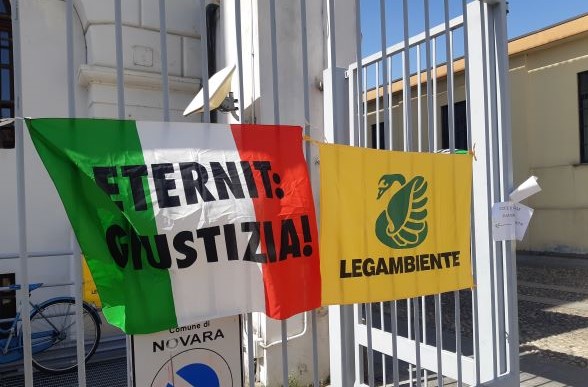
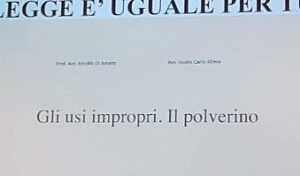
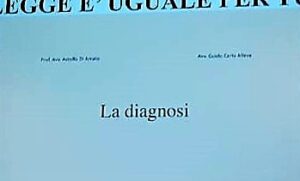
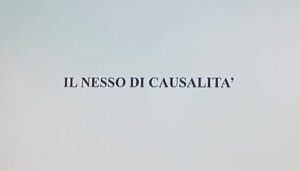
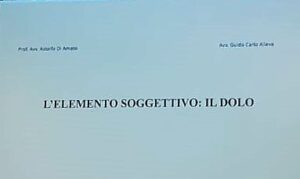
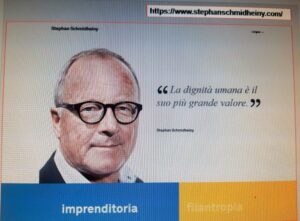
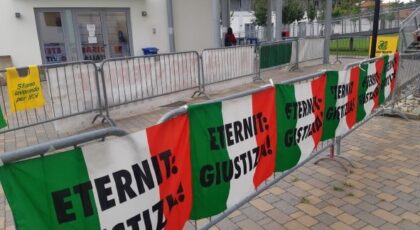
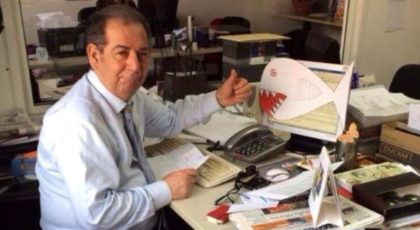
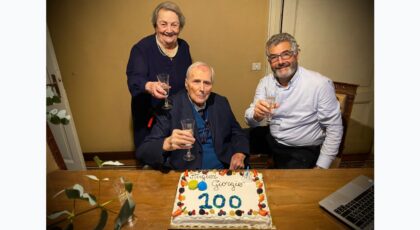
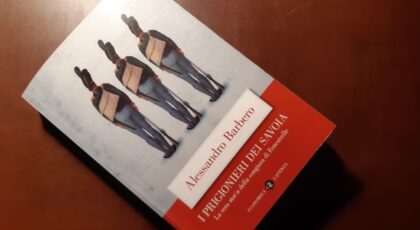
Grazie. Silvana . Restiamo in fiduciosa attesa.
Grazie tante Silvana, veramente un ottimo e molto mpegnativo lavoro!
Proprio così: la difesa ha puntato .moltissimo sul “polverino” … del periodo belga. Giustamente: la franymazione giornaliera! a cielo
aperto degli sscarti di lavorazione
era indispensabile per la funzione del mulino Azemag inaugurato in pieno periodo Smidhainy! E ,come ben noto, le fibre più sottili, che raggiungono più facilmente la profondita delle vie respiratorie, librano nell’aria anche fino a 24 ore, figuriamoci quei perenni polveroni con il vento fin dove arrivarono ( vedi sabbia delSaara), la maggior parte trattenuta dalla città di Casale e circondario…..
La fabbrica abbandonata con tonnellate di amianto ammucchiato sotto finestre rotte ed esposto ai 4 venti.
Tra l’altro si poteva entrare nella fabbrica abbandonata senza forzare alcun ingresso….
E ,giustamente come sovente sottolinei, S.S.non mosse un dito per allertare e riparare il disastro in corso,nonostante ne fosse perfettamente al corrente. Ciò grazie al diffuso e per lui costoso sistema di spionaggio, subito anche noi a Casale per 21 anni!…..
Grazie ancora Silavana e incrociamo le dita per il 7 giugno!
Grazie tante Silvana, veramente un ottimo e molto impegnativo lavoro!
Proprio così: la difesa ha puntato .moltissimo sul “polverino” … del periodo belga. Giustamente: la frantumazione giornaliera! a cielo
aperto degli scarti di lavorazione
era indispensabile per la funzione del mulino Azemag inaugurato in pieno periodo Smidhainy! E ,come ben noto, le fibre più sottili, che raggiungono più facilmente la profondita delle vie respiratorie, librano nell’aria anche fino a 24 ore, figuriamoci quei perenni polveroni con il vento fin dove arrivarono ( vedi sabbia del Saara), la maggior parte trattenuta dalla città di Casale e circondario…..
La fabbrica abbandonata con tonnellate di amianto ammucchiato sotto finestre rotte ed esposto ai 4 venti.
Tra l’altro si poteva entrare nella fabbrica abbandonata senza forzare alcun ingresso….
E ,giustamente come sovente sottolinei, S.S.non mosse un dito per allertare e riparare il disastro in corso,nonostante ne fosse perfettamente al corrente. Ciò grazie al diffuso e per lui costoso sistema di spionaggio, subito anche noi a Casale per 21 anni!…..
Grazie ancora Silavana e incrociamo le dita per il 7 giugno!
Grazie Silvana…come sempre puntuale e precisa nel rendiconto dell andamento udienza….ho letto e riletto…e dico solo…che nel 1898 Luky Deane ispettrice…già descrisse la malattia dri nonché e polmoni….subito dopo …i medici affermavano la pericolosità tumorale….
Quindi l arringa del difensore non ha nulla di umano…questo io penso…
Leggo, rileggo, non posso concepire che ci sia l’assoluzione per l’imputato.
Non è vendetta a tutti i costi, ma giustizia per i morti, per i vivi, per una città che ha pagato un prezzo fuori da ogni logica.
Grazie Silvana per la tua costanza e per le informazioni sempre dettagliate e comprensibili a tutti.
Grazie Silvana ottimo giornalismo!